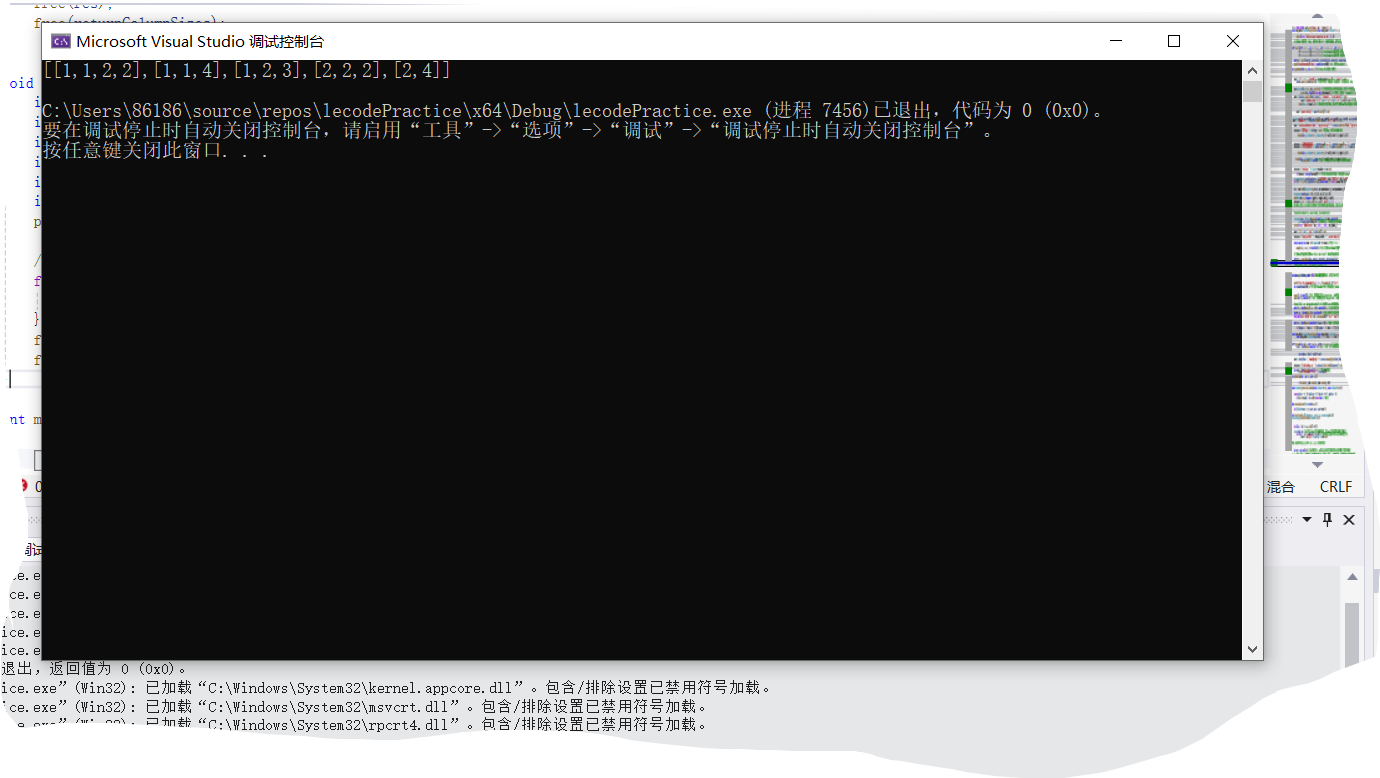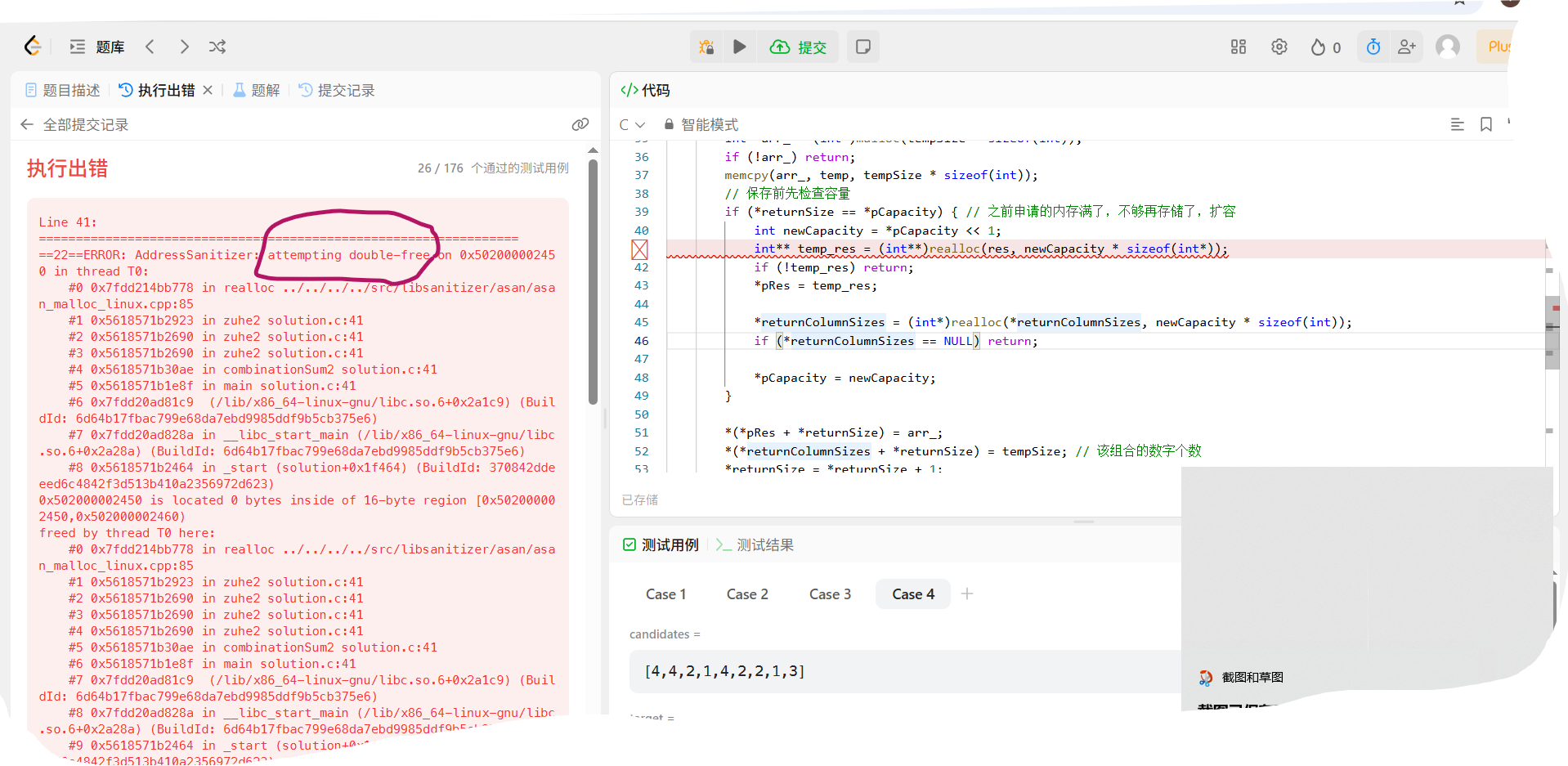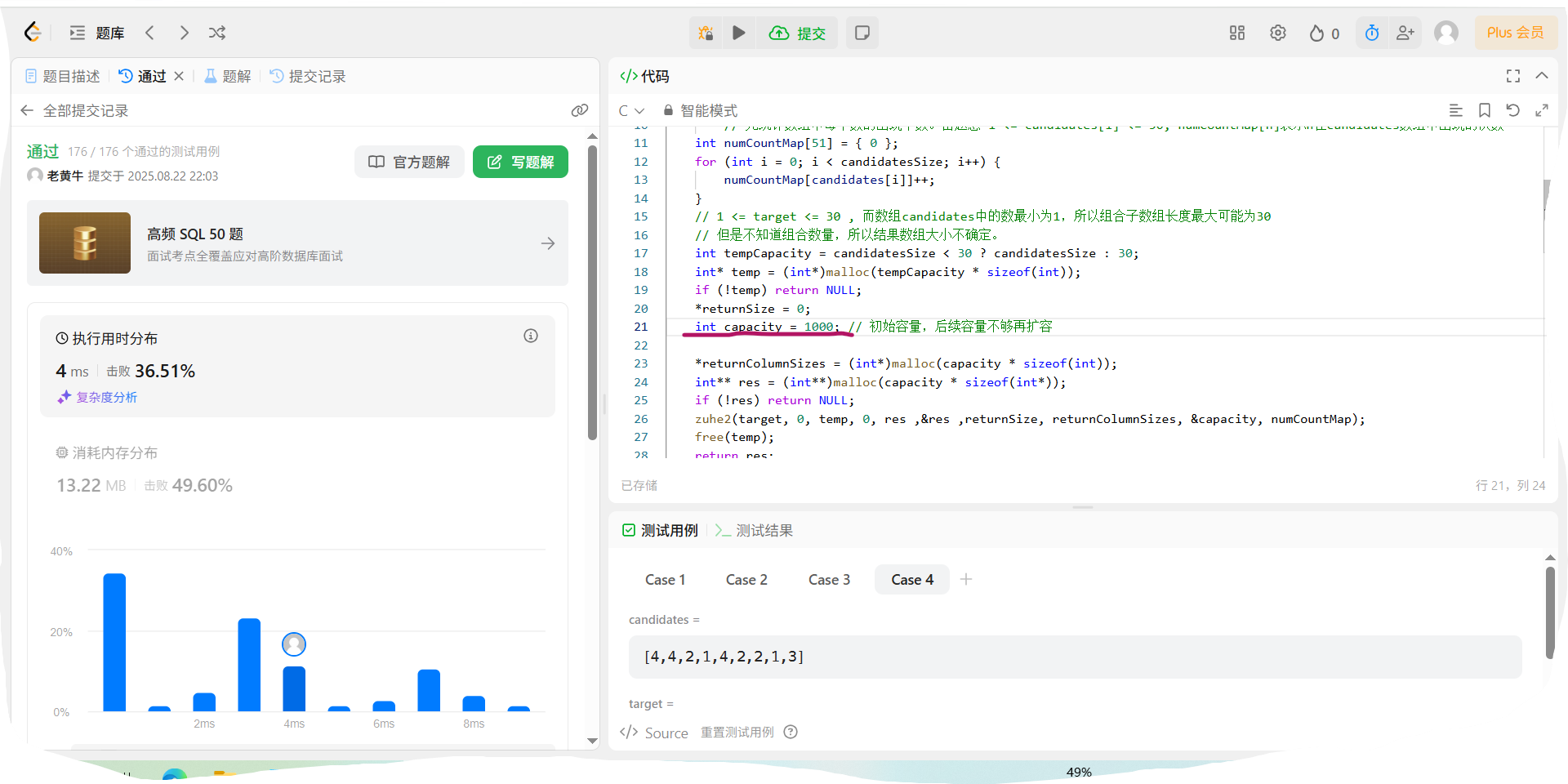给定一个候选人编号的集合 candidates 和一个目标数 target ,找出 candidates 中所有可以使数字和为 target 的组合。
candidates 中的每个数字在每个组合中只能使用 一次 。
**注意:**解集不能包含重复的组合。
示例 1:
输入: candidates = [10,1,2,7,6,1,5], target = 8,
输出:
[
[1,1,6],
[1,2,5],
[1,7],
[2,6]
]示例 2:
输入: candidates = [2,5,2,1,2], target = 5,
输出:
[
[1,2,2],
[5]
]提示:
1 <= candidates.length <= 1001 <= candidates[i] <= 501 <= target <= 30
答案如下:
cpp
void zuhe2(int target, int idx, int* temp, int tempSize
, int** res, int*** pRes, int* returnSize, int** returnColumnSizes, int* pCapacity, int* numCountMap);
/**
* Return an array of arrays of size *returnSize.
* The sizes of the arrays are returned as *returnColumnSizes array.
* Note: Both returned array and *columnSizes array must be malloced, assume caller calls free().
*/
int** combinationSum2(int* candidates, int candidatesSize, int target, int* returnSize, int** returnColumnSizes) { // LeetCode 40.组合和总和
// 先统计数组中每个数的出现个数。由题意 1 <= candidates[i] <= 50, numCountMap[n]表示n在candidates数组中出现的次数
int numCountMap[51] = { 0 };
for (int i = 0; i < candidatesSize; i++) {
numCountMap[candidates[i]]++;
}
// 1 <= target <= 30 , 而数组candidates中的数最小为1,所以组合子数组长度最大可能为30
// 但是不知道组合数量,所以结果数组大小不确定。
int tempCapacity = candidatesSize < 30 ? candidatesSize : 30;
int* temp = (int*)malloc(tempCapacity * sizeof(int));
if (!temp) return NULL;
*returnSize = 0;
int capacity = 2; // 初始容量,后续容量不够再扩容
*returnColumnSizes = (int*)malloc(capacity * sizeof(int));
int** res = (int**)malloc(capacity * sizeof(int*));
if (!res) return NULL;
zuhe2(target, 0, temp, 0, res ,&res ,returnSize, returnColumnSizes, &capacity, numCountMap);
free(temp);
return res;
}
void zuhe2(int target, int idx, int* temp, int tempSize
, int** res, int*** pRes, int* returnSize, int** returnColumnSizes, int* pCapacity, int* numCountMap) {
if (target == 0) {
// 已满足,保存结果
int* arr_ = (int*)malloc(tempSize * sizeof(int));
if (!arr_) return;
memcpy(arr_, temp, tempSize * sizeof(int));
// 保存前先检查容量
if (*returnSize == *pCapacity) { // 之前申请的内存满了,不够再存储了,扩容
int newCapacity = *pCapacity << 1;
int** temp_res = (int**)realloc(res, newCapacity * sizeof(int*));
if (!temp_res) return;
*pRes = temp_res;
*returnColumnSizes = (int*)realloc(*returnColumnSizes, newCapacity * sizeof(int));
if (*returnColumnSizes == NULL) return;
*pCapacity = newCapacity;
}
*(*pRes + *returnSize) = arr_;
*(*returnColumnSizes + *returnSize) = tempSize; // 该组合的数字个数
*returnSize = *returnSize + 1;
return;
}
for (int i = idx; i < 51; i++) {
// 先判断i是否使用过了
if (numCountMap[i] == 0) {
// 该数使用完了
continue;
}
if (i > target) {
break;
}
// 可以加的情况,选中该数
temp[tempSize++] = i;
numCountMap[i]--;
// 再递归选给临时数组下一位赋值。 注意,这里idx参数值必选传i,不能传idx,防止选到重复的组合。组合的临时数组中当前在选的数还可以选,但前面选过的数不能再选
zuhe2(target - i, i, temp, tempSize, res, pRes, returnSize
, returnColumnSizes, pCapacity, numCountMap);
// 回退,不选这个数了
tempSize--;
numCountMap[i]++;
}
}测试代码:
cpp
void testLeeCode40(void) { // 组合总和II
int nums[] = { 4,4,2,1,4,2,2,1,3 };
int target = 6;
int numsSize = sizeof(nums) / sizeof(int);
int returnSize; // 用于接受结果二维数组的长度。
int* returnColumnSizes; // 用来接受结果二维数组的每个元素(即子数组)的长度
int** res = combinationSum2(nums, numsSize, target, &returnSize, &returnColumnSizes);
printArr(res, returnSize, returnColumnSizes); // 打印二维数组
// 释放内存
for (int i = 0; i < returnSize; i++) {
free(res[i]);
}
free(res);
free(returnColumnSizes);
}运行:

ok. 但是提交到LeeCode,报错:

看上去是调用realloc函数时报错重复释放内存了。 但是没看出来哪里重复释放内存了。没懂这个报错哪来的,我自己机器上没报错。怎么办? 我把二维数组的容量直接设置为1000,1000应该是够用了,避免了动态扩容数组,提交通过了:

这个疑问点后面再研究。